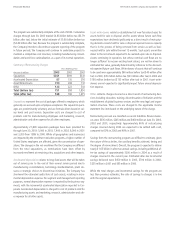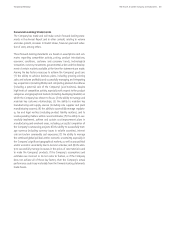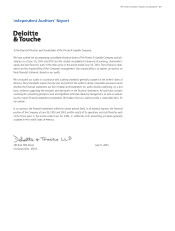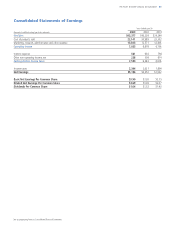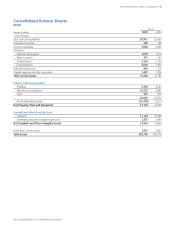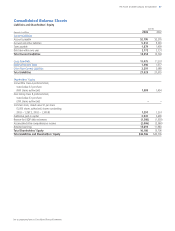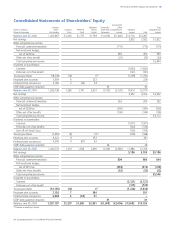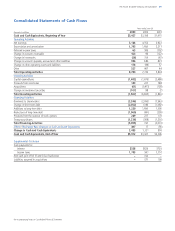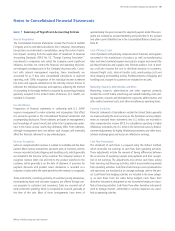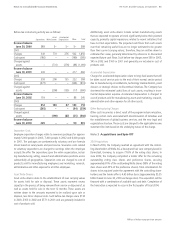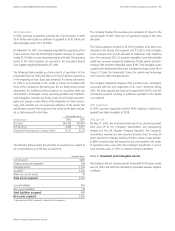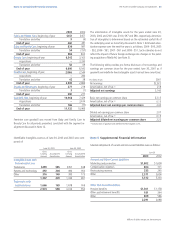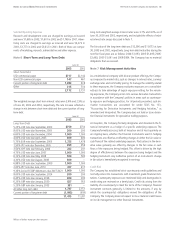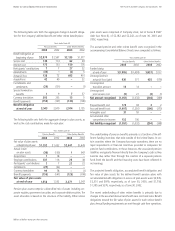Proctor and Gamble 2003 Annual Report Download - page 44
Download and view the complete annual report
Please find page 44 of the 2003 Proctor and Gamble annual report below. You can navigate through the pages in the report by either clicking on the pages listed below, or by using the keyword search tool below to find specific information within the annual report.42
Notes to Consolidated Financial Statements The Procter & Gamble Company and Subsidiaries
the need for a guarantor to recognize, at the inception of certain guar-
antees, a liability for the fair value of the obligation undertaken in issu-
ing the guarantee. The initial recognition and measurement provisions
of the Interpretation were adopted by the Company for guarantees
issued or modified after December 31, 2002. Adoption of FIN No. 45
did not have a material impact on the Company’s financial statements.
In January 2003, the FASB issued FIN No. 46, “Consolidation of Variable
Interest Entities.” FIN No. 46 addresses the requirements for business
enterprises to consolidate related entities in which they are determined
to be the primary economic beneficiary as a result of their variable eco-
nomic interests. The adoption of FIN No. 46 on July 1,2003 did not have
a material impact on the Company’s financial statements.
In April 2003, the FASB issued SFAS No. 149, “Amendment of State-
ment 133 on Derivative Instruments and Hedging Activities.” In May
2003, the FASB issued SFAS No. 150, “Accounting for Certain Financial
Instruments with Characteristics of both Liabilities and Equity.” The
Company will adopt both SFAS No. 149 and SFAS No. 150 on July 1,
2003 and does not expect these Statements to materially impact the
Company’s financial statements.
Note 2 Restructuring Program
In 1999, concurrent with a reorganization of its operations into prod-
uct-based global business units, the Company initiated a multi-year
restructuring program. The program was designed to accelerate growth
and deliver cost reductions by streamlining management decision mak-
ing, manufacturing and other work processes and discontinuing under-
performing businesses and initiatives. Costs include separation-related
costs, asset write-downs, accelerated depreciation and other costs
directly related to the restructuring effort.
Since inception, the overall program resulted in total charges of $4.85
billion before tax ($3.79 billion after tax). At the end of 2003, this
restructuring program was substantially complete.
Many restructuring charges are not recognized at project initiation, but
rather are charged to expense as established criteria for recognition are
met. This accounting yields ongoing charges over the entire restructur-
ing period, rather than a large reserve at initiation. Charges for the pro-
gram are reflected in Corporate because they are corporate-driven
decisions and are not reflected in the operating results used internally
to measure and evaluate the operating segments.
Reclassifications
Certain reclassifications of prior years’ amounts have been made to
conform to the current year presentation.
New Pronouncements
On July 1, 2001, the Company adopted SFAS No. 142, “Goodwill and
Other Intangible Assets.” SFAS No. 142 eliminates the amortization of
goodwill and indefinite-lived intangible assets and initiates an annual
review for impairment. Identifiable intangible assets with determinable
useful lives continue to be amortized.
On July 1, 2002, the Company adopted SFAS No. 143, “Accounting for
Asset Retirement Obligations,” and SFAS No. 144, “Accounting for the
Impairment or Disposal of Long-Lived Assets.” SFAS No. 143 addresses
the financial accounting and reporting for obligations associated with
the retirement of tangible long-lived assets and the associated asset
retirement costs. Adoption of this Statement did not have a material
impact on the Company’s financial statements. SFAS No. 144 addresses
the financial accounting and reporting for the impairment or disposal of
long-lived assets. This Statement did not have a material impact on the
Company’s financial statements.
The Company adopted SFAS No. 146, “Accounting for Costs Associated
with Exit or Disposal Activities,” for exit or disposal activities that were
initiated after December 31, 2002. This Statement requires these costs
to be recognized pursuant to specific guidance on when the liability is
incurred and not at project initiation. This Statement did not have a
material impact on the Company’s financial statements.
In December 2002, the Financial Accounting Standards Board (FASB)
issued SFAS No. 148, “Accounting for Stock-Based Compensation –
Transition and Disclosure.” This Statement amends the transition alter-
natives for companies choosing to adopt the fair value method of
accounting for the compensation cost of options issued to employees
and requires additional disclosure on all stock-based compensation
plans. The Company has adopted the disclosure provisions.
In November 2002, the FASB issued FASB Interpretation (FIN) No. 45,
“Guarantor’s Accounting and Disclosure Requirements for Guarantees,
Including Indirect Guarantees of Indebtedness of Others.” FIN No. 45
addresses the disclosures to be made by a guarantor in its financial
statements about its obligations under certain guarantees and clarifies
Millions of dollars except per share amounts


